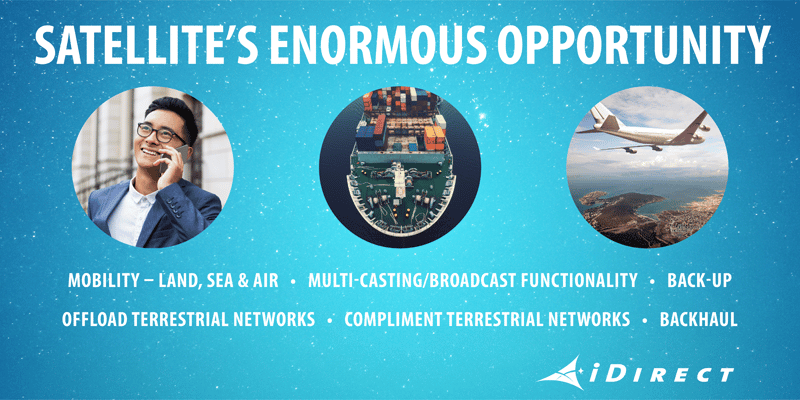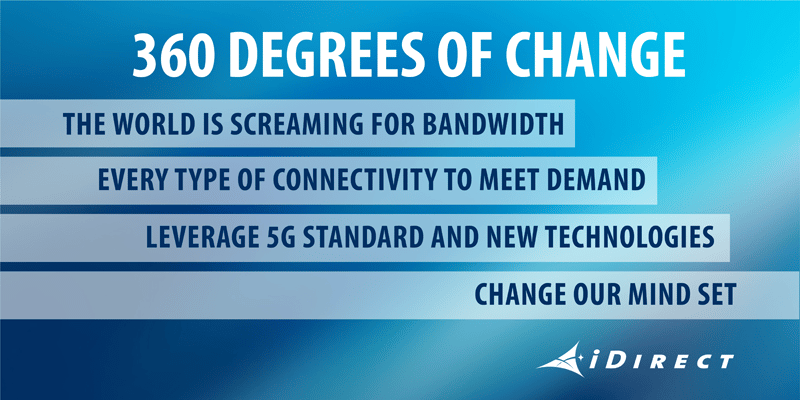 All signs point to a massive future for the satellite industry, but we’ve got to act now.
All signs point to a massive future for the satellite industry, but we’ve got to act now.
The satellite industry is buzzing like never before with innovation happening across all sectors. The goal is full-scale transformation to capture larger opportunity. Yet, there are plenty of ideas and debate on the best ways forward.
Kevin Steen, President & CEO, VT iDirect, recently keynoted at VSAT Congress 2018, sharing his insights on the top priorities for the industry to break into mainstream network services. For those of you who missed it, here are the highlights of Kevin’s presentation.
We are witnessing a revolution in the sky, driven by breakthrough satellite designs and constellations across GEO, MEO and LEO orbits. According to NSR, there will be 14X more capacity by 2027. This is projected to drive down the overall cost of satellite capacity to spur new growth and eventually mass adoption.
Satellite ground infrastructure leaders are innovating to open markets for all this capacity. They’re focusing on service roaming, sourcing bandwidth from multi-orbit constellations, leveraging software-defined architectures to enable low-cost, high-volume users over large-scale networks, and developing flat-panel antennas to enable critical new applications.
Mobile operators are innovating at the same pace, rallying around the 5G standard, an ambitious, game-changing effort to re-architect wireless networks to connect the world in unimaginable ways. A key element of the 5G standard is that it mandates the convergence of all access technologies into a unified force. And this will accelerate the integration of satellite and mainstream networks.
The telecom industry wants more endpoints to grow their customer base. Satellite has long been attractive but was a niche technology. Today, new standards, and the adoption of them, will change this dynamic.
In the context of an end-to-end 5G network, satellite connectivity helps “complete the play” of terrestrial and cellular networks. For example, bringing broadband connectivity to remotes or user endpoints on the move; to a home or office in underserved areas; or to enterprise sites as a backup solution.
Satellite can also be leveraged for traffic offloading and backhauling data from millions of smart devices and sensors inside homes and urban infrastructure. One of the biggest opportunities will be the connected vehicle where satellite’s inherent multi-casting functionality can efficiently handle applications like in-vehicle software updates.
Five Ways Forward
We’re at a pivotal moment in our development, and there are five innovation priorities that our industry must advance to help redefine our opportunity.
- Ensure mainstream network integration: To gain greater market share, satellite must function as an integrated part of the broader end-to-end network. A non-negotiable element of that is adopting mainstream telecom standards and operational practices. Most specifically, we must leverage Software-Defined Network (SDN), Network Function Virtualization (NFV) and Orchestration processes to deliver service rapidly across the right choice of access technology.
- Establish a new cost model for scale: To accommodate expansive network growth ahead, we need to reimagine how we scale network infrastructure – embracing virtualization and cloud computing to shed the weight of hardware and increase speed to market. This aligns with the adoption of SDN, NFV and Orchestration, enabling network operators and service providers to finance, provision and deploy networks in a more cost-effective and responsive manner.
- Expand efficiency to new levels: If we want satellite connectivity to play more than just a fringe role in the end-to-end network, we need to accomplish the first two items above as well as continually improve bandwidth efficiency. Today, it’s about DVB-S2X; tomorrow it’s supporting new Ultra-HTS designs with wideband transponders and intelligent payloads. Adopting intelligent payloads expands our measure of efficiency, connecting demand on the ground to dynamic capacity allocation onboard the satellite. Another focus must be around enabling orbital roaming, which can further optimize capacity usage.
- Foster a user endpoint ecosystem: If we are managing an integrated, intelligent network, then how do we advance the user endpoint and the local user experience? Collaboration needs to center on the concept of software-defined terminals. These would be engineered to support multiple waveforms and access technologies; integrate into 4G/5G wireless networks; upgrade over the air without service disruption; be able to leverage innovation at the edge device (MEC). With these innovations in place, satellite networks could support similar experiences and capabilities as terrestrial and cellular networks.
- Guarantee a seamless user experience: There is quite a bit to integrate across the backend of the end-to-end network, but one thing is certain: the end user can never be affected by or notice the complexity. That means service must be seamless across all access technologies, applications and geographies. For mobility applications, this presents a significant challenge with the only response being the enablement of roaming – the ability for a user endpoint to switch across satellite spot-beams, constellations, orbits, access technologies and autonomous service provider networks. The entire satellite ecosystem must partner in a very close way to make this possible.
Let’s Define Our Future Together
The world’s hunger for connectivity grows exponentially by the day. The telecommunications industry is responding with bold innovation. While every type of connectivity is necessary to meet this demand, it’s the integration of those connectivity options that will deliver real value to the end user.
At iDirect, we are moving towards a highly intelligent ground network that integrates all types of capacity, can handle massive scale, and deliver connectivity to the right application at the right cost.
Satellite has a unique value proposition to offer, and the path is open for satellite connectivity to leverage our unique value in a much bigger world of opportunity. It’s time to seize the opportunity to change satellite’s possibilities from limited to limitless.

